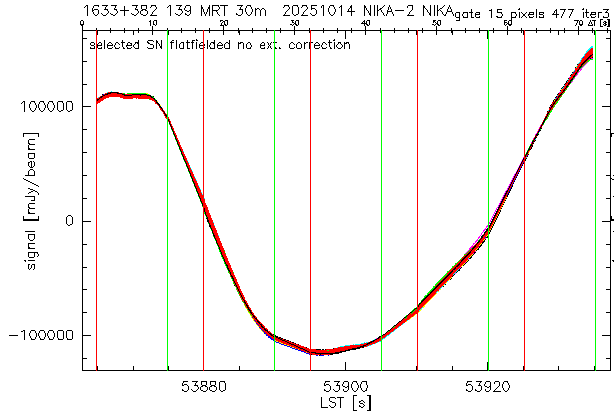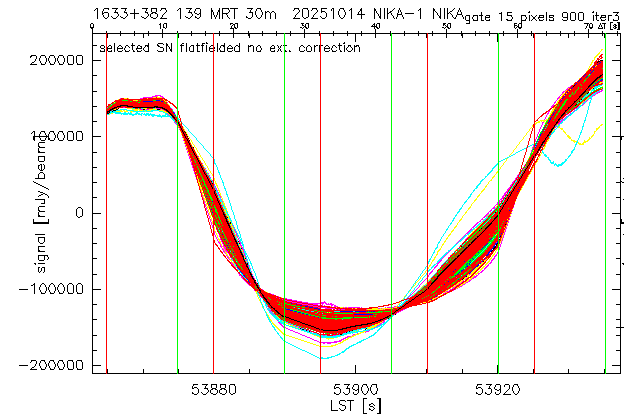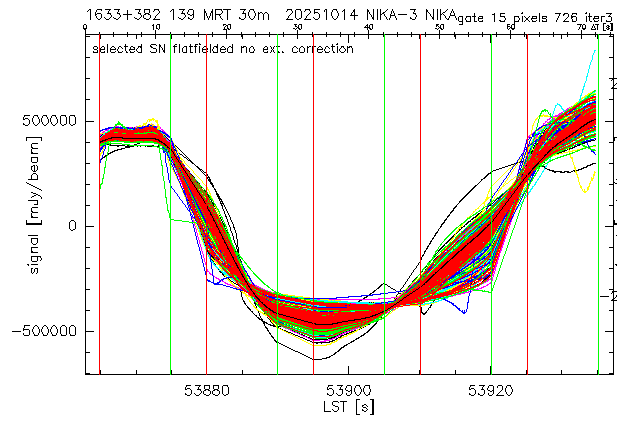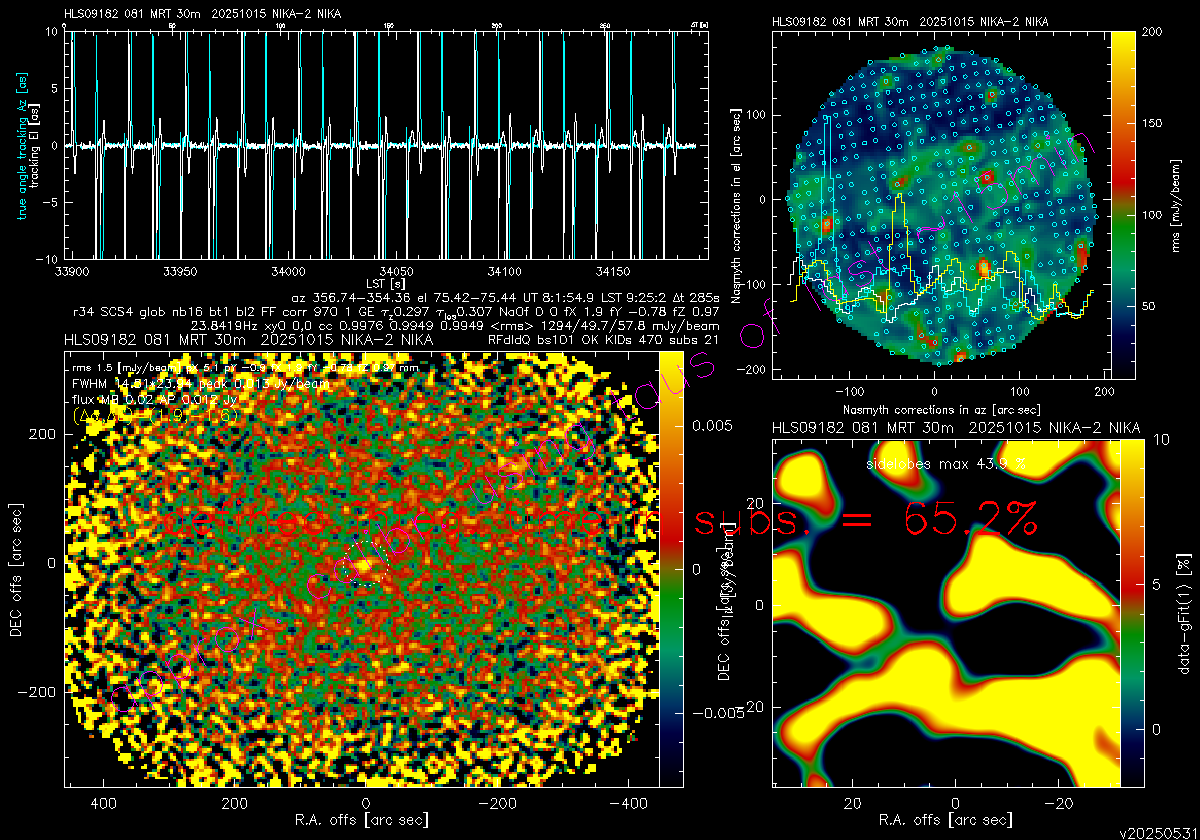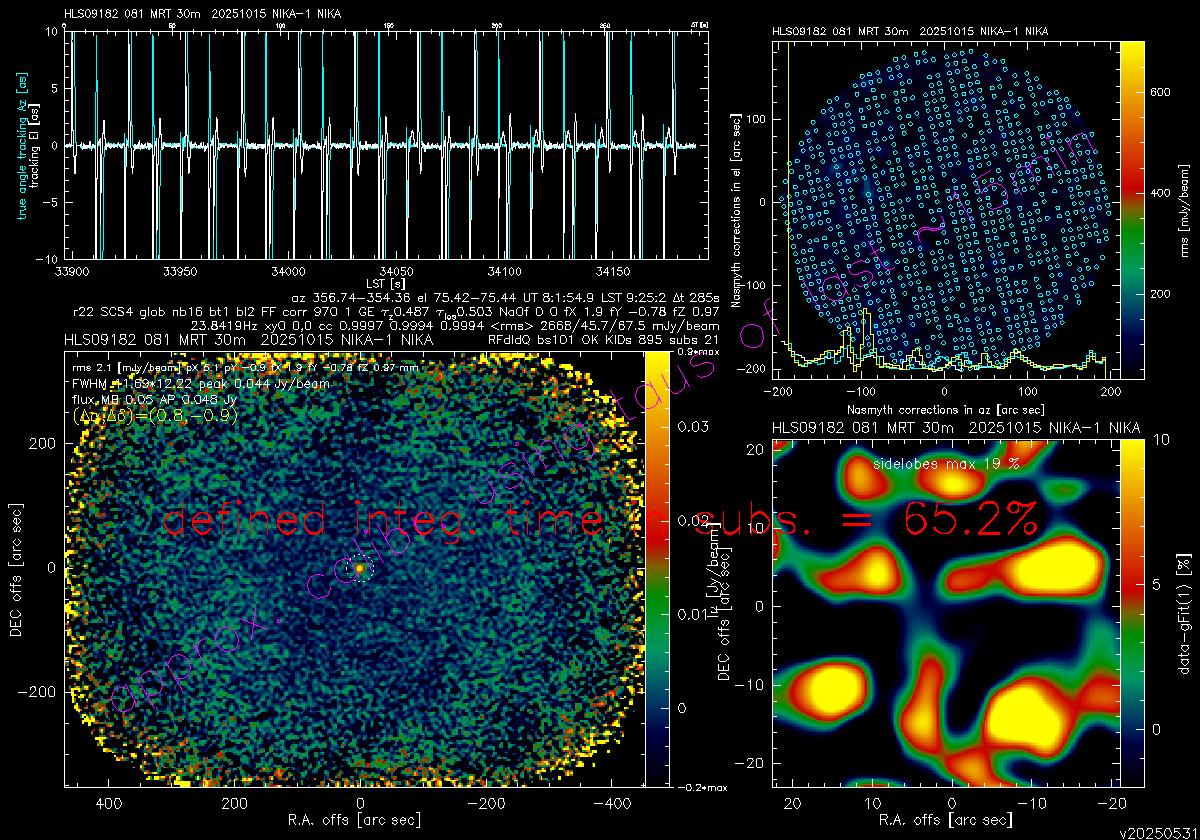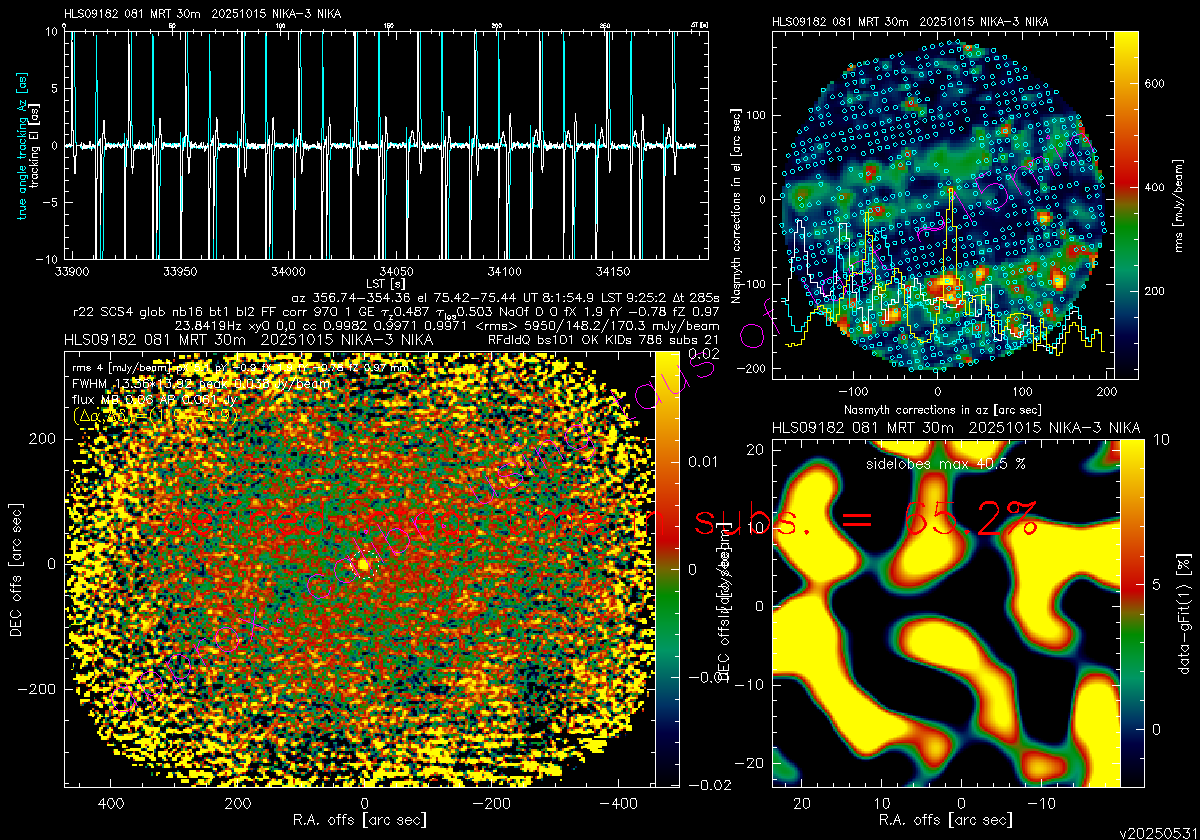Back to the NIKA2 Run 75 main page
Contents
NIKA2 Re-Commissioning (4th. attempt)
NIKA2 run 75, Cryo run 87
Oct. 13, 2025
14:00-17:00; Martino, Alessandro, Dave, Angel: a new sweep was performed. Previous initialization file: run87_old.ini. Bad/total KIDs counts (cryo window closed) after sweep (Ar1, Ar2, Ar3): 9/1000, 8/574, 4/1013. New file in force: run87_new.ini. Files run87_new_tp.ini and run87_new_pol.ini were also created. See nika2-a:~/nika_V3_IRAM.ini.
Oct. 14, 2025
Angel, Miguel, Stefano, and maaaany others arrive at the telescope.
We rename the ini files:
run87.ini (active file)
run87_old.ini (OLD active file, not used in August)
run87_newSweep_tp.ini
run87_newSweep_pol.ini
run87_oldSweep_tp.ini
run87_oldSweep_pol.ini
@15:00 LT (13:00 UT) we start, after preparing the whole "NIKA2 week environment architecture: 15/8/55 lost KIDs in Ar 1,2,3. Unstable sky and thick clouds coming from the N. We're entering in the peak of the tau forecast. It will be better later this evening. Meanwhile we try to focus. The old make-imbf script does not produce the imbfits files. Angel contacts Albrecht to solve the issue. The new make-imbf produces the file regularly.
On the very variable thick clouds, we notice a very different response of Ar1 and Ar3 to sky noise (variations), the latter having a bkg few times higher than the former (compare the y-axis scales). Is it real? Is there a flux calibration problem in the old DAFs? The a posteriori (19:00 LT) check does not reveal any calibration issue: Ar1 and Ar3 give similar fluxes for the targeted sources.
While we wait, some checks to some Antenna temperature control cables are being carried out by the telescope team. We start again 18:45 LT. The old make-imbf is now producing files correctly (thanks Albrecht!).
We work on the focus. Here follow our observations/notes. It is hard to get the focus value for all three arrays at once. The Ar2 flux criterion shows big jumps. The Ar2 FWHM and flux criteria do not agree. It almost seems like the flux is maximized not when the FWHM is minimized. Strange behavious, almost as if there were more than one "best" focus position. We enlarge the focus range of the 5 scans sequence. It was +/- 0.8 mm in steps of 0.4 mm. Now we changed it to +/- 1.0 mm, in steps of 0.5mm. The aim is to see if we can have a more complete sampling of the focus curve (for all criteria). The new script is called focusOTF-Z_2025.pako. We also try with a total excursion of +/-1.2 mm and steps of 0.6 mm. It seems that this latter solution is the best.
Is it possible that the difference in focus between Ar2 and Ar1 is changing? The first time it was ~0.3 mm. The second time it was ~0.6 mm. Now it is ~1.0mm??? At the same time, the focus difference between Ar1 and Ar3 seems stable at ~0.2 mm. It's early to be worried, but let's keep an eye on this! Nope, using the +/-1.2 mm excursion, we get back to 0.6mm difference between Ar2 and Ar1. Fiuuuu.
We alternate pointing/focus obtained with the old sweep and beam maps taken with the new one. The goal is to have at least two beam maps per array, taken with the optimal focus for that same given array. In the tables below, we list: focus sequences, beam maps, calib_1scan, other relevant scans, and a book keeping of sweep changes (to be used when defining the new calibration files - PIIC DAFs, for example - for this recommissioning run).
End of the day+night summary
At the end of the day+night, we have:
- 3 beam-maps on best focus for each array;
- one de-focused beam map at the Ar2 focus minus 0.3 mm and one at plus 0.3 mm;
- one de-focused beam map at the Ar3 focus plus 0.3 mm.
In this way, we cover the whole range from Ar2-0.3 to Ar3+0.3 with 6 focus positions: Ar2-0.3, Ar2, Ar2+0.3, Ar1, Ar3, Ar3+0.3. It might turn out that we need more positions in order to determne well the three focal surfaces.
Note that the latter 2 items (in the list above) have been performed when the taumeter opacity started to increase. Nevertheless the l.o.s. peak-to-peak sky noise variations kept being ~1 Jy/beam the whole time. If these last three beam maps have issues, we'll need to perform a whole sequence of 6-7 beam-maps at different focal positions, during a very stable night, such that the reference focus does not vary across the sequence (it takes few hours, hence the very stable need.)
Impressions about the difference in focus of the three arrays. The focus difference between Ar2 and Ar1 seems to be between 0.6 and 0.7 mm. The focus difference between Ar1 and Ar3 seems to be further 0.2-0.3 mm. The total focus difference between Ar2 and Ar3 reaches up to 1.0 mm. A decent compromise might be to use the focus of Ar1 as reference, but a quantitative analysis is needed to say the last word.
Tables (from 2025/10/14 ~13:00 UT to 2025/10/15 ~4:00 UT)
Focus sequences
Scan nr
Target
Ar2
Ar1
Ar3
Notes
20251014s161-165
2251+158
-0.3
+0.3
...
start at +0.2 mm; Big jumps in FWHM and flux during the focus sequence in Ar2
167-171
2251+158
~0.0
+0.9
1.1
start at +0.6 mm; Ar2 and Ar3 based on FWHM; El~40 deg; Ar2 FWHM and flux criteria do not agree
172-176
2251+158
-0.05
+1.0
~+1.2
start at +0.7 mm; custom script with 0.5 mm step instead of 0.4 mm; is the difference between Ar2 and Ar1 become larger?
177-181
2251+158
+0.13
+0.75
+1.0
start at +0.7 mm; custom script with 0.6 mm step instead of 0.4 mm; this is the best so far;
185-189
2251+158
+0.37
+1.21
...
start at +0.7 mm; custom script with 0.6 mm step instead of 0.4 mm
191-195
2251+158
+0.34
+1.12
+1.42
start +1.0 mm; custom
199-203
2251+158
~+0.40
+1.15
+1.40
start +1.2 mm; custom
208-212
2251+158
~+0.30
+1.05
+1.30
start +1.2 mm; custom
218-222
Uranus
~+0.24
+0.85
+1.05
start at +1.0 mm; custom; Ar2 not good, jumps and different criteria not consistent to each other
226-230
Uranus
+0.20
+0.90
+1.10
start at +0.85 mm; custom
20251015s8-12
Uranus
+0.30
+1.00
~+1.25
start at +0.7 mm; custom; Ar3 focus range poorly covered
19-23
Uranus
+0.28
+0.95
~+1.25
start at +0.7 mm; custom; Ar3 focus range poorly covered
28-32
Uranus
~+0.2
+0.95
~+1.3
start at +1.1 mm; custom; Ar2 focus range poorly covered
Beam maps (99 sub-scans) with the NEW SWEEP
Scan Nr
Target
Focus
Notes
20251014s183
2251+158
+0.15
Focus optimized For Ar2 @20:25 LT
20251014s197
2251+158
+0.34
Focus optimized For Ar2 @21:30 LT
20251014s205
2251+158
+1.40
Focus optimized For Ar3 @22:25 LT
20251014s206
2251+158
+1.40
Focus optimized For Ar3 @22:25 LT
20251014s214
2251+158
+1.05
Focus optimized For Ar1 @23:40 LT
20251014s215
2251+158
+1.05
Focus optimized For Ar1 @23:40 LT
20251014s224
Uranus
+1.05
Focus optimized For Ar3 @01:12 LT (15/10)
20251015s1
Uranus
+0.90
Focus optimized For Ar1 @01:55 LT
20251015s14
Uranus
+0.30
Focus optimized For Ar2 @03:20 LT
20251015s25
Uranus
+0.00
de-focused beam-map at the Ar2 focus minus 0.3 mm
20251015s26
Uranus
+0.60
de-focused beam-map at the Ar2 focus plus 0.3 mm (no re-pointing done)
20251015s34
Uranus
+1.60
de-focused beam-map at the Ar3 focus plus 0.3 mm (re-pointed on the de-focused Ar3)
Calibrators (calib_1scan with the NEW SWEEP)
Scan Nr
Target
Focus
Notes
20251014s225
Uranus
+1.05
Focus optimized For Ar3 @01:12 LT (15/10)
20251015s2
Uranus
+0.90
Focus optimized For Ar1 @01:55 LT
20251015s4
Neptune
+0.90
Focus optimized For Ar1 @01:55 LT
20251015s15
Uranus
+0.30
Focus optimized For Ar2 @03:20 LT
20251015s17
Neptune
+0.30
Focus optimized For Ar2 @03:20 LT
Other relevant scans with the NEW SWEEP
Scan Nr
Scan type
Target
Focus
Notes
20251015s5
Skydip
-
-
Book-keeping of SWEEP changes
Scan Nr
SWEEP
Notes
20251014s124 to s182
OLD
20251014s183
NEW
16/4/41 lost KIDs
20251014s184 to s196
OLD
20251014s197
NEW
16/9/26 lost KIDS
20251014s199 to s204
OLD
20251014s205 to s206
NEW
9/4/16 lost KIDs
20251014s207 to s213
OLD
20251014s214 to s215
NEW
12/3/17 lost KIDs
20251014s216 to s223
OLD
20251014s224 to s225
NEW
12/4/33 lost KIDs
20251014s226 to s231
OLD
20251015s1 to s5
NEW
13/3/31 lost KIDs
20251015s6 to s13
OLD
20251015s14 to s17
NEW
10/3/34 lost KIDs
20251015s18 to s24
OLD
20251015s25 to s27
NEW
10/5/35 lost KIDs
20251015s28 to s33
OLD
20251015s34
NEW
15/6/25 lost KIDs
Oct. 15, 2025
Summary
- Starting at 6 a.m. LT, after a long night by Stefano (see above in the Oct. 14th report). De-focused beam-map at the Ar3 focus + 0.3 mm finished successfully.
- Getting pointing and focus on Uranus (old sweep). Three calib_1scans on Uranus (with focus optimized for each array) + a skydip (new sweep).
@08:00: starting deep field observations of HLS091828 (new sweep, pointing & focus optimized Ar1, 9 x 5 sq.-arcmin scans at 4 PAs per round and 60 arcsec/s of scan speed). A total of XX rounds (YYh) were obtained. Average pwv ~7 mm. Peak-to-peak variations of raw timelines (2 mm) were between +/-1 and 5 Jy/beam (from focus sequences). Just for a quick-look checking before the creation of new RPPs, we got a single scan of HLS091828 with the old sweep (20251015s81). Screen-shots of PIIC plots are shown below:
Tables (from 2025/10/15 ~04:00 UT to 2025/10/XX ~YY UT)
Focus sequences
Scan nr
Target
Ar2
Ar1
Ar3
Notes
36-40
Uranus
+0.24
+0.91
+1.16
start at +0.9 mm; custom
47-51
Uranus
+0.25
+0.90
+1.20
start at +0.9 mm; custom
75-79
0716+714
+0.25
+0.97
+1.20
start at +0.9 mm; custom
100-104
0716+714
~ -0.35
+0.45
+0.77
start at +0.6 mm; custom; Ar2 range poorly covered
Beam maps (99 sub-scans) with the NEW SWEEP
Scan Nr
Target
Focus
Notes
Calibrators (calib_1scan with the NEW SWEEP)
Scan Nr
Target
Focus
Notes
20251015s42
Uranus
+0.23
Focus optimized For Ar2 @06:59 LT
20251015s43
Uranus
+0.91
Focus optimized For Ar1 @07:04 LT
20251015s44
Uranus
+1.16
Focus optimized For Ar3 @07:09 LT
Other relevant scans with the NEW SWEEP
Scan Nr
Scan type
Target
Focus
Notes
20251015s45
Skydip
--
--
--
20251015s55 to s66
science maps
HLS091828
+0.90mm
Optimized for ar1 (focus +0.90mm), 3 rounds (4 scans each) deep field (@202503/observe_DeepField)
20251015s82 to s97
science maps
HLS091828
+0.97mm
Optimized for ar1 (focus +0.97mm), 4 rounds (4 scans each) deep field (@202503/observe_DeepField)
20251015s109 to s140
science maps
HLS091828
+0.45mm
Optimized for ar1 (focus +0.45mm), 8 rounds (4 scans each) deep field (@202503/observe_DeepField)
Book-keeping of SWEEP changes
Scan Nr
SWEEP
Notes
20251015s35 to s41
OLD
20251015s42 to s45
NEW
14/3/34 lost KIDs
20251015s46 to s54
OLD
20251015s55 to s66
NEW
18/3/32 lost KIDs
20251015s67 to s81
OLD
20251015s82 to s97
NEW
17/5/46 lost KIDs
20251015s98 to s107
OLD
20251015s109 to s140
NEW
15/3/45 lost KIDs

